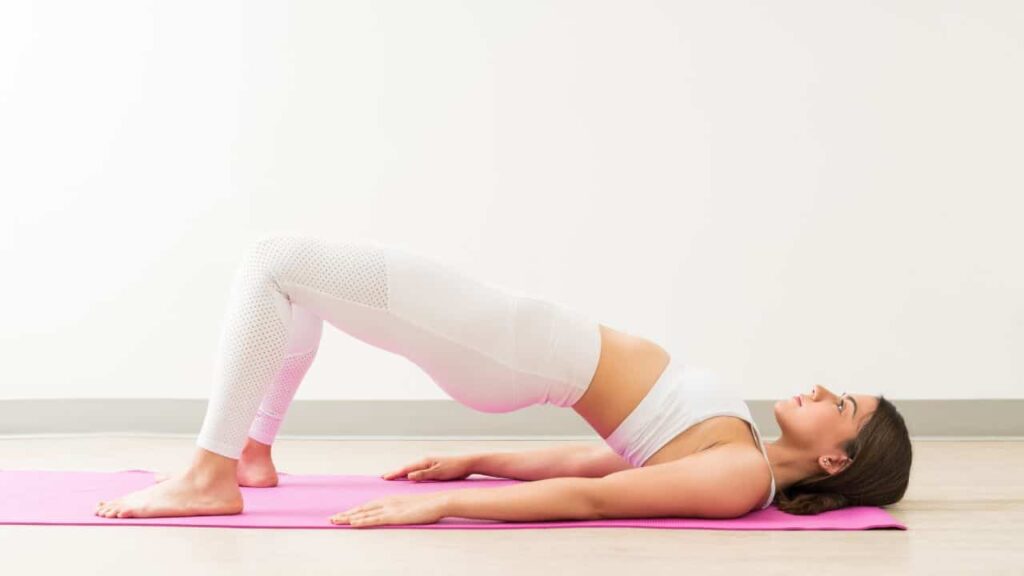PCOS (polycystic ovary syndrome), with its myriad of symptoms, can feel overwhelming at times—excess weight that seems impossible to shed, hormonal imbalances wreaking havoc on your body, and the emotional toll it takes on your journey to conceive. But fear not, yoga for PCOS offers a pathway to address these challenges holistically, nurturing your mind, body, and spirit.
Imagine engaging in an exercise regimen for PCOS that not only supports your weight loss efforts but also balances your hormones, reduces stress, and enhances fertility. Yoga for PCOS has the power to create a ripple effect, transforming not just your physical body but also your mental and emotional well-being.
Throughout this blog post, we’ll uncover the remarkable benefits of PCOS yoga such as its effects on embracing mindfulness, deepening your mind-body connection, and developing a sustainable practice that nurtures your entire being. We’ll guide you through a series of yoga asanas carefully curated to address your unique needs to balance hormonal fluctuations and overcome PCOS Symptoms.
Benefits of Yoga Poses for PCOS
Well, you see, it has been proven that you can improve PCOS with diet, exercise, and other lifestyle changes. A proper PCOS diet plan combined with the right exercise regimen can improve hormonal balance and fertility by as much as 80%. That’s a tremendous effect!
Here is where the power of yoga comes into play. Yoga, an ancient practice that integrates the mind, body, and spirit, has been proven to be a valuable tool in managing various health conditions, including PCOS. By incorporating specific yoga asanas (postures), pranayama (breathing techniques), and meditation, women with PCOS can find solace, balance, and a renewed sense of control over their bodies and lives.

1. Yoga can help to regulate your hormones
One of the biggest problems with PCOS is an imbalance in hormones related to high testosterone levels and low progesterone levels. This can lead to all sorts of issues, from weight gain, facial hair, infertility to mood swings.
Yoga practice can help to regulate your hormones and bring them back into balance. This can help reduce some of the more troublesome symptoms of PCOS.
One of the hormones disturbed in PCOS is insulin. Many PCOS patient struggle with insulin resistance. Regular yoga practice is a great way to improve insulin sensitivity.
2. Yoga can help to reduce stress hormone
Stress is one of the worst things for PCOS. It can trigger hormonal imbalances, make symptoms worse, and even cause weight gain. If you’re looking for ways to reduce stress, yoga could be a good choice for you to boost your mental health. The deep breathing and relaxation techniques learned in yoga can help to ease stress and anxiety.
3. Yoga can help you to lose weight
Weight gain is a common symptom of PCOS, but it can also make the condition worse. If you’re carrying around extra weight, it puts more strain on your hormones and can make symptoms like fatigue and insulin resistance worse. Luckily, yoga can help with weight loss. The combination of deep breathing, increased physical activity, and stress reduction can all help to boost your metabolism and help you shed those extra pounds.
4. Yoga can improve your fertility
If you’re hoping to one day start a family, yoga might be able to help. PCOS fertility challenges are a common issue, but yoga can actually improve your chances of conception. The relaxation techniques learned in yoga can help to reduce stress hormone, while the physical activity can help to regulate your hormones and improve your overall health. All of these things combined can give you a better chance of conceiving when you’re ready to start a family.
Best Yoga Poses for PCOS
Without further ado, let’s see which yoga pose are especially beneficial for weight loss and hormonal balance in PCOS.
1. Bhujangasana (Cobra pose)

It helps in regulating the menstrual cycle. This pose improves blood circulation in the pelvic region. It improves fertility.
How to perform Bhujangasana:
- Lie on your chest with your elbows close to your body and palms facing down.
- Inhale while slowly straightening your arms to lift your chest off the floor. Keep reclining back through this. Make sure your navel is touching the floor.
- Hold this posture for 15-30 seconds.
- Gradually exhale and come back down.
2. Dhanurasana (Bow pose)

This yoga asana helps to relieve menstrual discomfort. It stimulates the reproductive organ.
Dhanurasana also regulates the menstrual cycle. It is a great yoga asana to practice for adolescent girls who struggle with irregular periods and period cramps.
How to perform Dhanurasana:
- Lie on your stomach with your arms by your sides
- Keep your feet hip-width apart
- Now lift your legs and chest up to form an arc
- Try to hold on to your feet if you can
- Hold this position for about 30 seconds
3. Supta Badhakonasana (Reclining butterfly pose)

It opens up the pelvic area. It relaxes the body systems
How to perform:
- Lie down on your back and relax.
- Pull your legs together in a butterfly position.
- Pull your feet as close to your body as you can. Hold them with your hands.
- You can support your posture with a cushion under your hip.
- Hold the posture for 5 minutes, then take a break and repeat.
4. Setu Bandha Sarvangasana (Bridge pose)

This pose regulates thyroid function, which is a big step towards hormone balance. Also, the bridge pose stimulates the internal abdominal organs. It relieves symptoms of poor digestion, gas and bloating, which is very important in managing PCOS.
How to perform:
- Lie on your back
- Keep your feet flat on the ground and raise your knees.
- As you do this, you should also be pulling your knees towards your body.
- Stretch out your arms so you can touch your heels
- Slowly raise your back and hips to the ground as you go.
- Hold this position for a short while
5. Shalabhasana (Locust pose)

Addresses ovary as well as uterine disorders. As we know PCOS affects the ovaries, and so this is a good pose for PCOS. The locust is also beneficial for diabetes, which is a complication of PCOS.
How to perform:
- Lie on your chest with arms along your sides
- Raise your chest and your legs
- Keep your arms pointed backward like you wanted to touch your laps
- Hold the position for about 30 seconds and return to the original position. Then repeat.
6. Surya Namaskar (Sun Salutation)

Sun Salutation is a great way to start your day as it helps to energize the body. It is also a great way to stretch the muscles, boost fat metabolism and treat hormonal imbalance.
How to perform:
- Face the morning sun while standing in a prayer pose.
- Slowly stretch your folded hands backwards in a reclining posture and inhale.
- Now exhale and bring your hands forward, bend your knees and place your hands on your feet.
- Bend your right knee and stretch the right leg behind while placing your left leg forward in an athlete position. Look up.
- Exhale and raise your hip and tailbone in the air to make an inverted V (downward dog pose) with your body.
- Breathe in and get in position to launch into cobra pose by placing your hands near your shoulders and raising your buttock.
- Launch into the cobra pose by lifting your chest and bending backwards.
- Slowly now rewind your steps and come back to the position you started in.
- Repeat on the other leg
7. Naukasana (Boat Pose)

The boat pose is one of the best yoga asanas for PCOS. Also, it helps to reduce body fat, improves blood flow to the reproductive organs, and enriches the function of the ovaries.
How to perform:
- Lie on your back, with your feet joined together
- Place your arms resting beside your body
- Take a deep breath to lift your head, chest and feet off the floor with your hands stretched towards your feet
- Keeping your fingers and toes straight, exhale deeply.
- Feel the tension in your navel and abdominal muscles
- Maintain this pose for 30 seconds, then bear to starting position
8. Marjaryasana and Bitilasana (Cat and Cow Pose)

Yoga poses like cat and cow pose cause a lot of movement in the spine and help to relax tight shoulders and necks. They also stimulate and massage the abdominal muscles the reproductive organs and boost the functions of the nervous system.
It helps to induce ovulation and treat menstrual disorder related to irregular period.
How to perform:
- You should start on all fours
- Then, decline your head lowered and arch your spine upwards to form an arch that looks like a cat; wait for five seconds
- After that, return to your original position
- Continue this opposite arch with the spine as often as you like while swaying the spine in the opposing tack towards the ground
- Now repeat these opposite arches as many times as you want
9. Padma sadhana (Lotus Meditation)

More popularly known as the lotus meditation, this asana promotes deep relaxation, making it perfect for yoga for PCOS. Sitting in a padmasana throughout the menstrual cycle can significantly reduce cramps in women.
Padmasadhna is helpful to promote hormonal balance and fertility. The entire yoga sequence consists of a set of asanas:
- Sit in a half-lotus position and spin your body four times in each direction, clockwise and anticlockwise.
- Transition to Makarasana, also known as the crocodile position, by lying down on your stomach on the floor with your head lifted and your feet perpendicular to the ground.
- Lift your feet off the floor one at a time, gradually transitioning to Ardha salabhasana.
- Place your palms beneath your pelvis and elevate both limbs off the floor to progress to Poorna salabhasana.
- Now it’s time for Bhujangasana, which involves progressively bending backwards while keeping both hands near the shoulders. Your head should gaze up and your navel should remain on the floor.
- Move into Viprit Salabhasana, maintaining your stomach on the mat and raising your hands and legs off the floor.
- To execute Dhanurasana, grasp both of your feet with your hands in a bow shape with your torso
10. Pranayama (Breathing Exercises)

They are good for your heart and lungs. Pranayama exercises are very relaxing. They can eliminate toxins from the body. There are several breathing exercises for PCOS that you can try out. They include:
- Padmansana
- Anulom vilom pranayama
- Chandranadi (left nostril breathing)
- Brahmri (humming breath)
- Sitkari (cooling breaths)
- Bhastrika (bellows breath)
For instructions on how to carry out these breathing techniques and other benefits, check out this guide to pranayama.
Ayurvedic Health Tips to make the most of yoga for PCOS
- Don’t eat a heavy meal before a yoga class or session.
- Stay hydrated. Drink water before, during, and after the class.
- Ask for help where you need to.
- Have your yoga mat.
- Wear comfortable clothing.
- Pick a spot that is comfortable for you.
- Go at your own pace.
- Importantly, don’t forget that yoga is not just a form of exercise. It is a way of life. Manage PCOS with Yoga by regular practice.
Conclusion
Living with PCOS (Polycystic Ovary Syndrome) can often feel overwhelming and isolating, as finding effective relief from the symptoms can be a complex journey. Integrating yoga into your daily routine is a gentle step towards balance and well-being, offering both physical and emotional support. But we understand that you may need more comprehensive and personalized care to address the root causes of PCOS.
At Medhya Herbals, our Ayurvedic Doctors are committed to providing individualized treatment plans that align with your unique needs and lifestyle. Ayurvedic treatments, combined with yoga practices, can offer a holistic path to permanent relief, treating not just the symptoms but the underlying imbalances that lead to PCOS.
Don’t let the battle with PCOS control your life. Reach out to Medhya Herbals Ayurvedic Doctors and schedule a consultation today. Together, we can create a personalized treatment plan that embraces the wisdom of Ayurveda and yoga, empowering you to live a harmonious and vibrant life free from the challenges of PCOS. We’re here with you, every step of the way.
FAQ
1. Can PCOS be cured by yoga?
Yoga is a mind and body practice with historical origins in ancient Indian philosophy. Various styles of yoga combine physical postures, breathing techniques, and meditation or relaxation. There is compelling evidence that yoga can be beneficial for those suffering from PCOS. One study showed that after 3 months of practicing yoga 3 times per week, participants had significant reductions in insulin levels and waist circumference.
In another study, women who practiced yoga for 12 weeks had significantly lower levels of testosterone, luteinizing hormone, and fasting insulin levels. Yoga has also been shown to improve mental well-being in women with PCOS. One study showed that after 12 weeks of practicing yoga, participants had significantly lower levels of anxiety symptoms and depression. Overall, the evidence suggests that yoga may be an effective treatment for PCOS.
2. Which exercise is best for PCOS?
Polycystic ovary syndrome (PCOS) is a hormonal disorder that affects women of childbearing age. The condition can cause a variety of symptoms, including irregular periods, acne, and weight gain. While there is no cure for PCOS, exercise can be an effective way to manage the condition.
There are a number of different exercises that can help to ease the symptoms of PCOS. One of the best options is yoga. Yoga helps to promote balance in the body and mind, and can help to reduce stress levels. Additionally, yoga can help to improve insulin sensitivity and regulate hormone levels. Other good exercises for PCOS include walking, swimming, and cycling. These activities can help to boost energy levels, promote weight loss, and ease stress.
If you have PCOS, it’s important to consult with your doctor before starting any new exercise routine. They can help you to create a plan that is safe and effective for you.
3. How yoga helps in weight loss in PCOS?
Yoga is an effective weight loss tool for women with PCOS for a number of reasons. First, yoga helps to reduce stress, which is a common trigger for hormonal imbalances in women with PCOS. Secondly, yoga helps to improve insulin sensitivity, which is often impaired in women with PCOS. thirdly, the mindfulness component of yoga can help women with PCOS to be more aware of their eating habits and make better choices when it comes to food.
Lastly, the physical postures and breathing exercises of yoga help to stimulate the metabolism and promote fat burning. In sum, yoga is a comprehensive approach to weight loss that can be highly effective for women with PCOS.
4. Which is the best exercise for pcos to get pregnant?
PCOS or polycystic ovarian syndrome is a hormonal disorder that affects women of reproductive age. The main symptoms of PCOS are irregular periods, excess male hormone levels, and insulin resistance. PCOS can also lead to fertility problems, weight gain, and sleep apnea. While there is no cure for PCOS, there are treatments that can help manage the symptoms. One of the most important things you can do if you have PCOS is to exercise regularly. Exercise helps to regulate hormone levels, improve insulin sensitivity, and boost fertility. It can also help you lose weight, which can reduce your risk of developing other complications associated with PCOS. While any type of exercise is beneficial, some exercises may be more effective than others in treating PCOS.
One study found that women who did three hours of aerobic exercise per week had significantly lower levels of insulin and testosterone than those who didn’t exercise at all. Another study showed that women who did yoga had improved insulin sensitivity and better menstrual regularity than those who didn’t do yoga.
So, if you have PCOS and are hoping to get pregnant, regular exercise is a good place to start. Talk to your doctor about what type of exercise is right for you and how much
5. Ayurveda for PCOS Treatment
In Ayurveda, we believe in using food and exercise as medicine. When it comes to PCOS, there are a few key areas that we focus on. First, we work to stabilize blood sugar levels. This is because insulin resistance is a common symptom of PCOS, and high blood sugar can exacerbate symptoms like weight gain, fatigue, and mood swings.
To stabilize blood sugar, we recommend eating regular meals made with balanced amounts of healthy fats, proteins, and complex carbohydrates. We also recommend getting regular exercise, which can help to improve insulin sensitivity. In addition, we work to promote liver health.
The liver is responsible for detoxifying the body, and in women with PCOS, it is often working overtime to process excess hormones. To support liver health, we recommend eating plenty of leafy greens and other antioxidant-rich foods. We also suggest avoiding processed foods and alcohol, which can tax the liver.
Finally, we focus on reducing stress levels. Stress can trigger hormonal imbalances in women with PCOS, so it’s important to find ways to relax and de-stress on a regular basis. Yoga, meditation, and spending time in nature are all great ways to healthy living.
References
- Impact of yoga and exercises on polycystic ovarian syndrome risk among adolescent schoolgirls in South India
- Effect of yoga on polycystic ovarian syndrome: A systematic review
- Impact of yoga and exercises on polycystic ovarian syndrome risk among adolescent schoolgirls in South India
- Effect of integrated approach of yoga and naturopathy on polycystic ovarian syndrome: A case study


Love this website
Thank you so much 💝💝💝💝💗💗💗💗
Irregular prieod, hair fall, unwanted belly hair growth